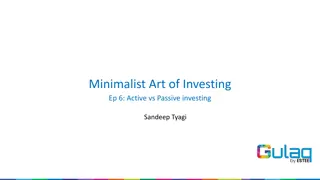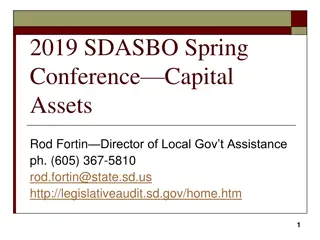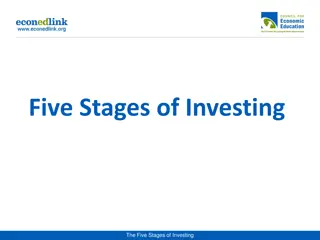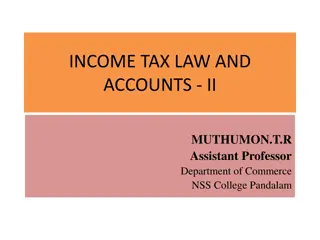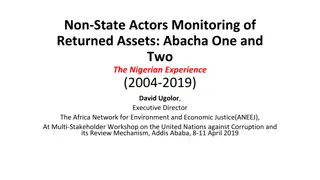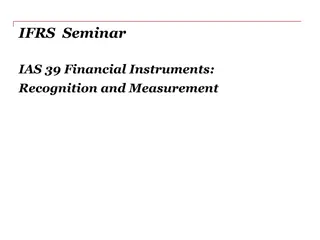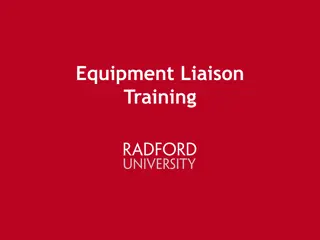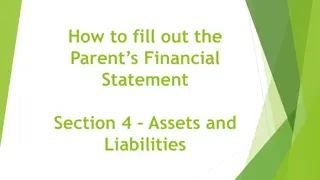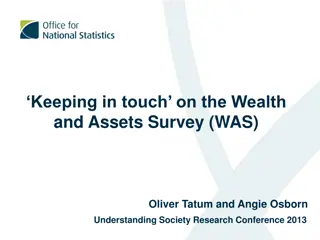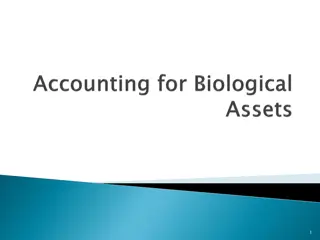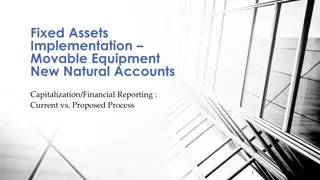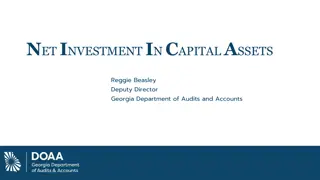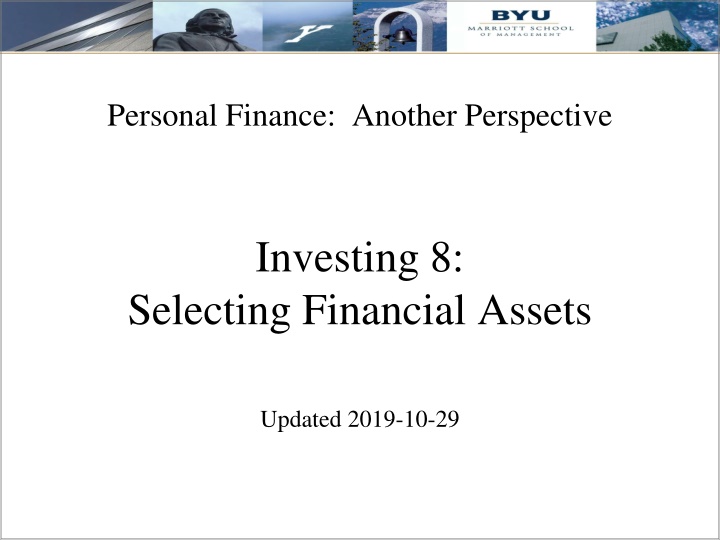
Why Waiting to Pick Stocks is Wise in Personal Finance
Discover why it's recommended to delay picking stocks until your assets have grown substantially. Understand key principles like diversification, low-cost investing, and the importance of building a strong knowledge base before selecting individual stocks. Learn how focusing on asset classes can improve returns and reduce risk in your investment portfolio.
Download Presentation

Please find below an Image/Link to download the presentation.
The content on the website is provided AS IS for your information and personal use only. It may not be sold, licensed, or shared on other websites without obtaining consent from the author. If you encounter any issues during the download, it is possible that the publisher has removed the file from their server.
You are allowed to download the files provided on this website for personal or commercial use, subject to the condition that they are used lawfully. All files are the property of their respective owners.
The content on the website is provided AS IS for your information and personal use only. It may not be sold, licensed, or shared on other websites without obtaining consent from the author.
E N D
Presentation Transcript
Personal Finance: Another Perspective Investing 8: Selecting Financial Assets Updated 2019-10-29
Objectives A. Understand why you should wait to pick stocks (until your assets have grown substantially) B. Understand where to find important information on mutual funds and stocks and taxes on financial assets C. Understand what makes a good mutual fund and the big deal about index funds D. Understand how to pick the mutual/index funds for your portfolio E. Understand plans and strategies for picking financial assets 2 2
A. Understand why you shouldnt be picking stocks until later Why have we not yet talked about picking stocks? There are five major reasons why we have not talked about picking stocks. Picking single stocks initially violates the following investing principles: 1. Principle 3: Stay Diversified Picking single stocks violates the principle of diversification, especially when you are just beginning to build your portfolio With a small portfolio, it is difficult to achieve acceptable diversification with limited numbers of stocks 3 3
Stock Selection Strategies (continued) 2. Principle 4: Invest Low-cost and tax-efficiently Investing in stocks when you have a small portfolio (less than $500,000) is very expensive. Transactions costs for purchasing stocks are among the highest of any major asset class 3. Principle 6: Know What You Invest In Picking stocks when you have not developed the knowledge and skill base necessary to evaluate stocks is very risky, bordering on speculation or gambling Most (and this includes Finance students) have not yet developed the skills needed to make good stock selection decisions for a portfolio 4 4
Stock Selection Strategies (continued) 4. Principle 8: Don t spend too much time trying to Beat the Market Picking stocks is very difficult and challenging task There is so much more to be learned about valuation that can t be taught in a single class. I have given only the very basics in this course 5. Stock selection is not required to have a successful investment portfolio While it is intellectually challenging to select stocks, you can generally improve returns and reduce risk more by properly selecting asset classes. You may never need to buy an individual stock 5 5
Questions Any questions on why you shouldn't be picking stocks until later? (Remember, since analyzing companies is not likely going to be many of your daytime jobs, it will be in most of your best interests to develop a sleep-well portfolio plan and follow it.) 6 6
B. Understand where to find Information on Financial Assets and Taxes Where do you find mutual fund, bond and stock information? Stockbrokers Mutual Fund Supermarkets Schwab, Fidelity, TD Waterhouse Mutual Fund Monitoring companies Morningstar, Lipper Financial Websites and the Financial Press Yahoo, MSN Money, CNN Money Kiplinger s, Smart Money, AOL Finance BYU Libraries HBLL has great information See TT10 7 7
Mutual Fund Information (continued) What is the best format for the information? In a database of consistent, pertinent information that is updated on a regular basis The database must be directly searchable with a consistent framework and structure One example: Morningstar Note that this is just one of the many available databases. By choosing this database, I am neither implying or endorsing Morningstar (although I think they are pretty good). It is just that it is available free in the library 8 8
Taxes on Financial Assets All investment earnings are not created equal. There are different taxes and tax rates on different types of financial assets. Some have preferential federal, and others preferential state tax rates Taxes fall under three main headings: a. Stocks, b. Bonds and Savings vehicles, and c. Mutual funds (which include index funds and exchange traded funds) Note that each of these assets are taxed at the federal level and may be taxed at the state and local level as well, depending on your state of residence. Many are taxed at your marginal tax rate (MTR), which is your highest tax rate, the tax on each additional dollar of income 9 9
Taxes on Financial Assets (continued) A. Stocks (or Equities) There are two main types of taxes on stocks 1. Capital gains are earnings from selling a stock. Short-term are from stocks held < 366 days Long-term are from stocks held >= 366 days 2. Stock dividends are qualified or ordinary Qualified dividends are held > 60 days during the 121-day period beginning 60 days before the ex-dividend date (see Taxes on Securities Earning Including Qualified Dividends (LT32) Ordinary dividends are dividends that are not qualified 10 10
Taxes on Financial Assets (continued) B. Bonds and Savings Vehicles Bond taxes are mainly two types: capital gains taxes and taxes on interest/coupon payments 1. Capital gains include both short-term and long-term capital gains, and are the gains received from the realized sale of the bonds that are related to price appreciation 2. Interest/coupon payments are payments received as part of the contractual agreement to receive interest payments Bonds which have preferential interest tax treatment, i.e., muni s and Treasuries, must still pay capital gains taxes 11 11
Taxes on Financial Assets (continued) C. Mutual Funds Mutual funds are pass through vehicles, which means that taxes are not paid at the Fund level but are passed through to the individual shareholders who must pay the taxes. Mutual fund taxes are mainly capital gains, stock dividends and interest/coupon payments. They are handled the exact same way as the taxes for stocks and bonds discussed earlier 12 12
Chart 1. 2019 Tax Brackets, Capital Gains and Dividends, and Medicare Tax Rates (000s) Married Filing Filing Single Jointly Household - 9.70 39.48 39.38 84.20 160.73 204.10 434.55 510.30 Taxes on Different Types of Earnings - 2019 (LT32) for Stocks, Bonds, and Mutual Funds Cap. Gains Total Cap Gains & Medicare Head of Ordinary& Dividends Income 10% 12% 22% Medicare Tax Rate Types of Investment Earnings: Federal Tax Rate State Tax Rate ** Tax Rate Earned Inc.* Invest. Inc. 0% 0% 0% 15% 15% 15% 15% 20% 20% Stocks: Capital Gains Short-term capital gains Long-term capital gains * Long-term capital gains (TI>$488MFJ) * Dividends Stock Dividends: Qualified *** Stock Dividends: Ordinary/Not Qualified 168.40 321.45 408.20 488.85 612.35 - 160.70 204.10 461.70 510.30 - Marginal Tax Rate Marginal Tax Rate Marginal Tax Rate Marginal Tax Rate Preferential, 0%, 15% 20% + 19.40 78.95 78.75 13.85 52.90 52.75 84.20 2.9% 2.9% 2.9% 2.9% 2.9% 2.9% 3.8% 3.8% 0.0% 0.0% 0.0% 0.0% 0.0% 0.0% 3.8% 3.8% 2.9% 2.9% 17.9% 17.9% 17.9% 17.9% 27.6% 27.6% Preferential, 0%, 15% Marginal Tax Rate Marginal Tax Rate Marginal Tax Rate Bonds and Savings Vehicles: Capital Gains Short-term capital gains Long-term capital gains * Long-term capital gains (TI>$488MFJ) * Interest/Coupon Payments Interest Payments Treasury-bills/bond Interest Muni-bond Interest (bonds from your state) Muni-bond Interest (bonds from another state) 24% 32% 35% Marginal Tax Rate Marginal Tax Rate Preferential, 0%, 15% 20% + Marginal Tax Rate Marginal Tax Rate Marginal Tax Rate Marginal Tax Rate Marginal Tax Rate 0% 0% 0% 0% Marginal Tax Rate 37% Mutual Funds (Pass Through Vehicles): Distributions: Capital Gains for Stocks/Bonds/Municipals Short-term capital gains Long-term capital gains * Long-term capital gains (TI>$488MFJ) * Stock Dividends Stock: Dividends: Qualified *** Stock Dividends: Not Qualified/Ordinary Interest/Coupon Payments Bond: Interest Treasury-bills/bonds Interest Muni-bond Interest (bonds from your state) Muni-bond Interest (bonds from another state) * Combined rate = 1.45% employer contribution. Marginal Tax Rate Marginal Tax Rate Marginal Tax Rate Marginal Tax Rate Preferential, 0%, 15% 20% + Definitions Short-term capital gains: Gains where shares/bonds that were sold were held for one year or less Long-term capital gains: Gains where shares/bonds that were sold were held more than one year Tax Notes * Capital gains taxes are taxed differently based on your taxable income and AGI (see Chart 1) ** State tax rates vary state to state, while some states do not have a state income tax *** Qualified dividends are dividends which are paid by a U.S. corporation and you held the stock for more than 60 days during the 121-day period that begins 60 days before the ex-dividend date (see the Qualified Dividends tab on this worksheet to see if your dividends qualify for the lower rate). Preferential, 0%, 15% Marginal Tax Rate Marginal Tax Rate Marginal Tax Rate Marginal Tax Rate Marginal Tax Rate Marginal Tax Rate 0% 0% 0% 0% Marginal Tax Rate 13 13
Questions Any questions on taxes on where to find information on financial assets and taxes on financial assets? 14 14
C. What Makes a Good Mutual Fund? What are the criteria for a good mutual fund? 1. Good diversification 2. Low cost 3. Tax efficiency 4. Low turnover 5. Low un-invested Cash 6. No manager style drift 7. Small (or positive) tracking error Please note that these slides refer to Morningstar Pages for specific funds. The first title is the Morningstar Button. The second is the tab (separated by a colon if available), and the third is the heading (separated by a dash). For example, Portfolio: Portfolio Market Capitalization, refers to the Market Capitalization heading from the Portfolio tab of the Portfolio button 15 15
1. Good Diversification Diversification is your key defense against market risk Stay diversified at all times. Pick a fund with many companies in their portfolios within each asset class Diversification your primary defense against things that might go wrong in investing Remember where you are in the hourglass Avoid sector (industry) funds, individual stocks or concentrated portfolios of any kind until you have sufficient education, experience, and assets And even then, keep that percentage of these assets small in relation to your overall assets 16 16
Where do you find Diversification? Diversification by: Numbers (Portfolio: Holdings) Total: Number of Stock, Bond, and Other Holdings Concentration: Assets in top 10 holdings Type (Portfolio: Summary) Type of holdings (stocks, bonds, cash) Location (Portfolio: Summary) World Regions: Location of companies invested in by geographic area Sector Weightings (Portfolio: Summary) Sector (or industry) weightings 17 17
Good Diversification 1b 1a 18 18 Source: All Morningstar charts are from Morningstar Library Edition, 2019-03-05
2. Low Cost Invest low cost In a world where investment returns are limited, investment costs of any kind reduce your returns Invest in no-load mutual funds You should rarely (if ever) pay a sales load of any kind (front end, level load, 12-b1, etc.). Rear-end loads are OK, since you are long- term investor, as long as the loads are less than 180 days Keep management fees to the lowest possible within the sector Remember: A dollar saved is a dollar you can earn more money with (and that has already been taxed) 19 19
Where do you find costs? Costs (Expense) Expense Relative to Category This is a key ratio: Total Expense Ratio Compare that to your category average Maximum Sales Fees (or Loads) Initial Deferred Redemption Other Fees/Expenses Administrative costs Management fees 12b-1 Fees 20 20
Low Cost (Fees and Expenses) 2e 2b2c 2d 21 21 2f Source: Morningstar 2019
3. Tax Efficiency Invest in taxable funds with an eye to obtaining high returns while keeping taxes low Taxes reduce the amount of money you can use for your personal and family goals Watch the historical impact of taxes, for it will likely continue Remember: It is not what you earn, but what you keep after taxes that makes you wealthy 22 22
Where do you find Tax Efficiency? Tax analysis Pretax Return: Return before taxes Tax-adjusted Return: Return after taxes Tax Cost Ratio: The percent of nominal Fund return attributable to taxes, assuming the fund is taxed at the highest rate. If a fund had an 8.0% return, and the tax cost ratio was 2.0%, the fund took home (1 + return) * (1 tax cost ratio) -1 or (1.08*.98)-1 or 5.84% Potential Cap Gains Exposure: An estimate of the percent of a funds asset s that represent gains. If this is high, the probability is high that these may come to the investor as capital gains 23 23
Tax Efficiency 3b is the average of 1 yr -15 yr rank in category 24 24 Source: Morningstar 2019
4. Low Turnover Keep turnover low, as it s a proxy for fund expenses and taxes The costs associated with turnover are hard to quantify and may not be disclosed in the prospectus. These costs include commissions, bid-ask spreads, and market impact Each transaction generates a taxable event for you, and these cumulative costs can be very expensive. Stick to funds with the low turnover (and low management fees), as they generally have lower costs and are more tax efficient as well 25 25
Where do you find Turnover? Turnover Annual Turnover (Portfolio: Holdings, Quote) This is the Fund turnover Category Average Turnover (Portfolio: Holdings) This is the turnover of Fund s in the same asset class or category 26 26
Low Turnover 4a 27 27 Source: Morningstar 2019
5. Low Un-invested Cash High cash levels are drags on performance. Keep un-invested cash low Many funds hold cash to fund potential redemptions, or as part of their investment policy, which are drags on performance Choose funds that are fully invested (95%-99% depending on the asset class and fund size) in the market segment that you are targeting Do not pay others to manage cash Please note that some frictional cash is OK though for open-end mutual funds 28 28
Where do you find Un-invested Cash? Un-invested Cash (or cash drag) Percent of cash in the fund (Snapshot - Asset Allocation) 29 29
Un-invested Cash 5a Source: Morningstar 2019 30 30
6. No Manager Style Drift Make sure the managers investment style remains constant Investment fund managers have no authority to change the asset class If you purchase a small cap fund, the manager should purchase small cap shares The fund's prospectus should clearly define the market, size company, and portfolio style tilt If you are looking for a domestic small value fund, screen for funds with the all of their assets invested in the U.S., the smallest average company size, and the highest book-to-market (or lowest price-book) ratios 31 31
Where do you find Manager Style drift? 6a 32 32 Source: Morningstar 2019
7. Low (or positive) Tracking Error Tracking error should be small Tracking error is the historical difference between the return of a fund (i.e. a mutual fund) and its specific market/sector benchmark or index. The smaller the tracking error, the better the performance of the Index fund relative to the benchmark However, you won t complain if the tracking error is positive (i.e., your fund had higher returns than the index or benchmark) 33 33
Where do you find Tracking Error? Tracking Error (Performance: Growth of $10k) Returns. Fund annual returns +/- S&P 500 TR. This is tracking error versus the S&P 500 Index (+/- Index). Note that Morningstar s choice of index is sometimes very poor, i.e., using MSCI EAFE for emerging markets +/- Category. Tracking Error versus the Category. In this case it is large cap blend. This is a better check on performance versus all funds in a similar category % Rank in Category (Number is in top %--the lower the number the better) 34 34
Tracking Error Source: Morningstar 2019 7a 35 35
Mutual Fund Information (continued) For help with how to select funds, see Using Morningstar to Select Mutual Funds (LT07) using the HBL Library or the Internet. Record what you have found with each candidate and select the funds using Mutual Fund Worksheet (LT07B) (note: the Filled In tab gives some work previous students have done on specific funds) 36 36
What is the Big Deal About Index Funds? What are index funds? Mutual funds or ETFs which hold specific shares in proportion to those held by an index Their goal is to match the benchmark performance Why have they come about? Investors are concerned that most actively managed funds have not been able to beat their benchmarks after all fees, taxes and costs. So instead of trying to beat an index, investors accept the index return and risk Interestingly, index funds have tended to outperform most actively managed funds 37 37
Index Funds (continued) Why have index funds and ETFs grown so quickly? There is no correlation between last year s winners and this year s winners for actively managed funds Actively managed funds tend to reduce performance through excessive trading, which also generates taxes for the investor Actively managed funds generally have higher management fees which must be overcome through higher returns (18 basis points for an index fund versus 80-250 basis points for an actively fund) It is very difficult to beat these funds on a consistent basis after all fees and taxes 38 38
Index Funds (continued) Jason Zweig, a senior writer for Money Magazine commented: With an index fund, you're on permanent auto- pilot: you will always get what the market is willing to give, no more and no less. By enabling me to say "I don't know, and I don't care," my index fund has liberated me from the feeling that I need to forecast what the market is about to do. That gives me more time and mental energy for the important things in life, like playing with my kids and working in my garden (Jason Zweig, Indexing Let s You Say Those Magic Words, CNN Money, August 29, 2001). 39 39
Index Funds (continued) Warren Buffet commented: By periodically investing in an index fund, the know-nothing investor can actually outperform most investment professionals. Paradoxically, when 'dumb' money acknowledges its limitations, it ceases to be dumb (Warren Buffett, Letter to Berkshire Hathaway Shareholders, 1993). Doing reasonably well investing in stocks is very, very easy. Buy an index fund, preferably over time, so you end up owning good businesses at a reasonable average price. If you own a cross- section of American businesses, you are going to do well ( Warren Buffet: Top 3 Investment mistakes to avoid, USA Today, October 26, 2013). 40 40
Index Funds (continued) Insights on Indexing Most actively managed funds will under-perform index funds in the long run after all taxes, costs and fees (according to research) Competition in stock-market research is intense and will get more competitive going forward, making markets more efficient and indexing more attractive Indexing or passive investing is a free-ride on the competition Indexing is a time-efficient and cost-effective way to invest due to eliminating the need to evaluate individual securities and low turnover and distributions 41
Questions: Any questions on what makes a good mutual fund and the big deal of index funds? 42 42
D. Understand How to Pick Mutual Funds The process to pick YOUR mutual funds is: 1. Determine the asset classes needed for your Plan and choose the appropriate benchmarks - Done 2. Determine what makes a good mutual fund and which asset classes you need exposure 3. Using a database program, set those principles and evaluate each of the potential mutual funds 4. Select the best mutual funds using Using Morningstar to Select Funds (LT07) and Mutual Fund Selection Worksheet (LT7B) (with hints on the Filled in tab) 5. Now put your Investment Plan together 43 43
Picking Your Mutual Funds (continued) Assume your asset class was Large Cap, and you choose SWPPX for your fund. What next? 1. Go to Morningstar, and type the ticker SWPPX in upper right box Where it says PDF Report (if available), print off this report. If there is no PDF Report, just print off the entire Quote Page. Include these in your Investment Plan as Exhibit III. Fund Support Exhibits 44 44 If you need help, see Mutual Fund Selection Worksheet (LT7B), Filled In for possible fund ideas and tickers
Picking Your Mutual Funds (continued) 2. Download the Investment Process Spreadsheet (LT13) For most, the first tab (4-10 assets) will be sufficient. Put in your Salary and emergency fund goal and percentage. It will automatically determine your target portfolio fund size (your emergency fund amount divided by your bonds/cash percentage). Assuming a salary of $60,000 and a 25% allocation to bonds and cash. Your target portfolio size would be $100,000. 45 45
Picking Your Mutual Funds (continued) 3. Add data to the Investment Process Spreadsheet (LT13) Put in your asset classes and benchmarks, and percentages in Panel I. Use the dropdown boxes for asset classes and benchmarks Then put in the tickers and Fund names 46 46
Picking Your Mutual Funds (continued) 4. Print off all your Exhibits Print off your filled in Exhibit I. Expected Return Simulation (LT27) Print off your filled in Exhibit II. Investment Process Spreadsheet (LT13) Print off Exhibit III. Mutual Fund Pages from Morningstar. There should be a minimum of 4 funds from 4 different asset classes Include these with your completed and filled in Investment Plan and you should be good 47 47
Plans and Strategies for Selecting Financial Assets Following are a few ideas for plans and strategies for picking financial assets Plans and Strategies General Will you use mutual funds or individual stocks/bonds? I recommend mutual/index funds as they give immediate diversification and low cost With a broadly diversified fund, you get the performance of the asset class and do not need to know much about each individual stock Most students, including business students, have not yet developed the skills necessary to effectively analyze individual stocks and bonds 48 48
Selecting Financial Assets (continued) General (continued) If you choose to invest passively: I recommend index funds for diversification, low cost, tax efficiency and returns Broadly diversified index funds eliminate most of the required work to understand the individual stocks and bonds in the portfolio If you choose to invest actively Monitor performance versus benchmarks over 24 and 36 months If you do both passive and active, that is also OK Determine your target asset allocation and follow it Ensure your chosen assets give exposure to the asset classes you need 49 49
Review of Objectives A. Do you understand why you shouldn t be picking stocks until the deepen phase when your assets and experience have grown? B. Do you understand where to find important information on mutual funds? C. Do you understand what makes a good mutual fund? D. Do you understand index funds and why they are attractive investment assets? E. Do you understand taxes on financial assets? F. Do you understand how to pick the mutual/index funds for your portfolio? F. Do you understand plans and strategies for picking financial assets? 50 50


